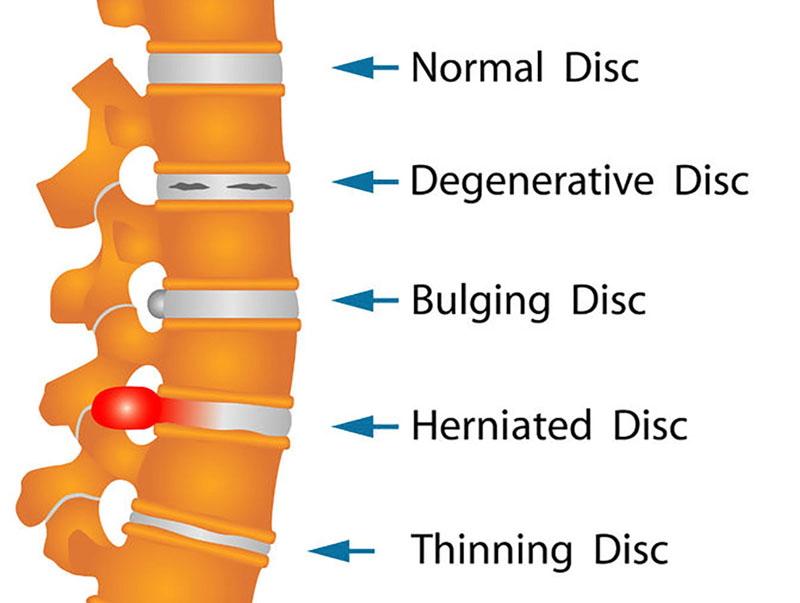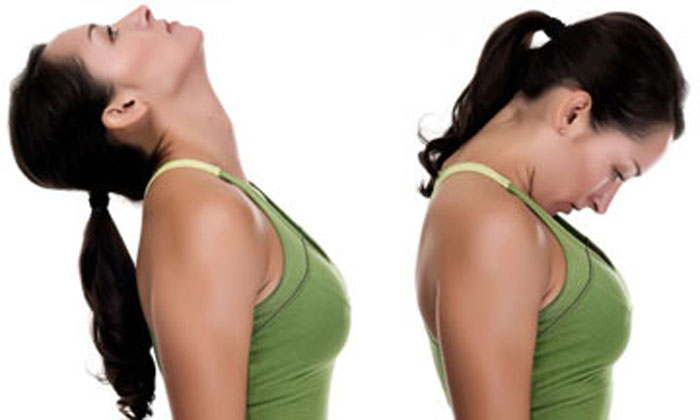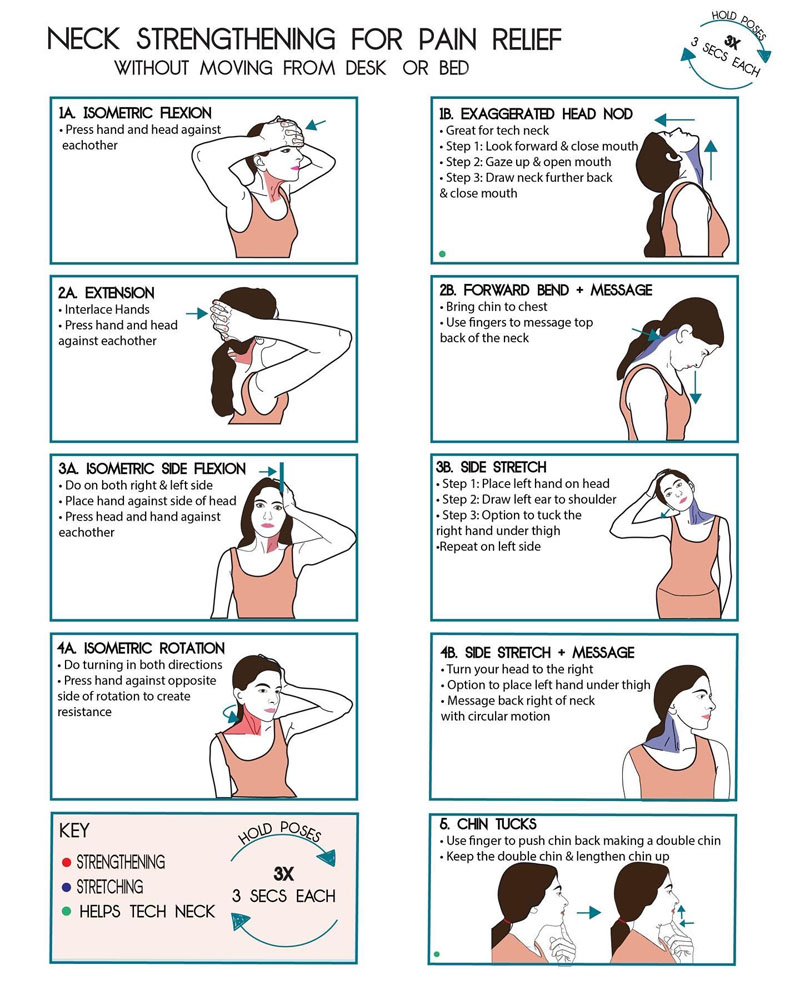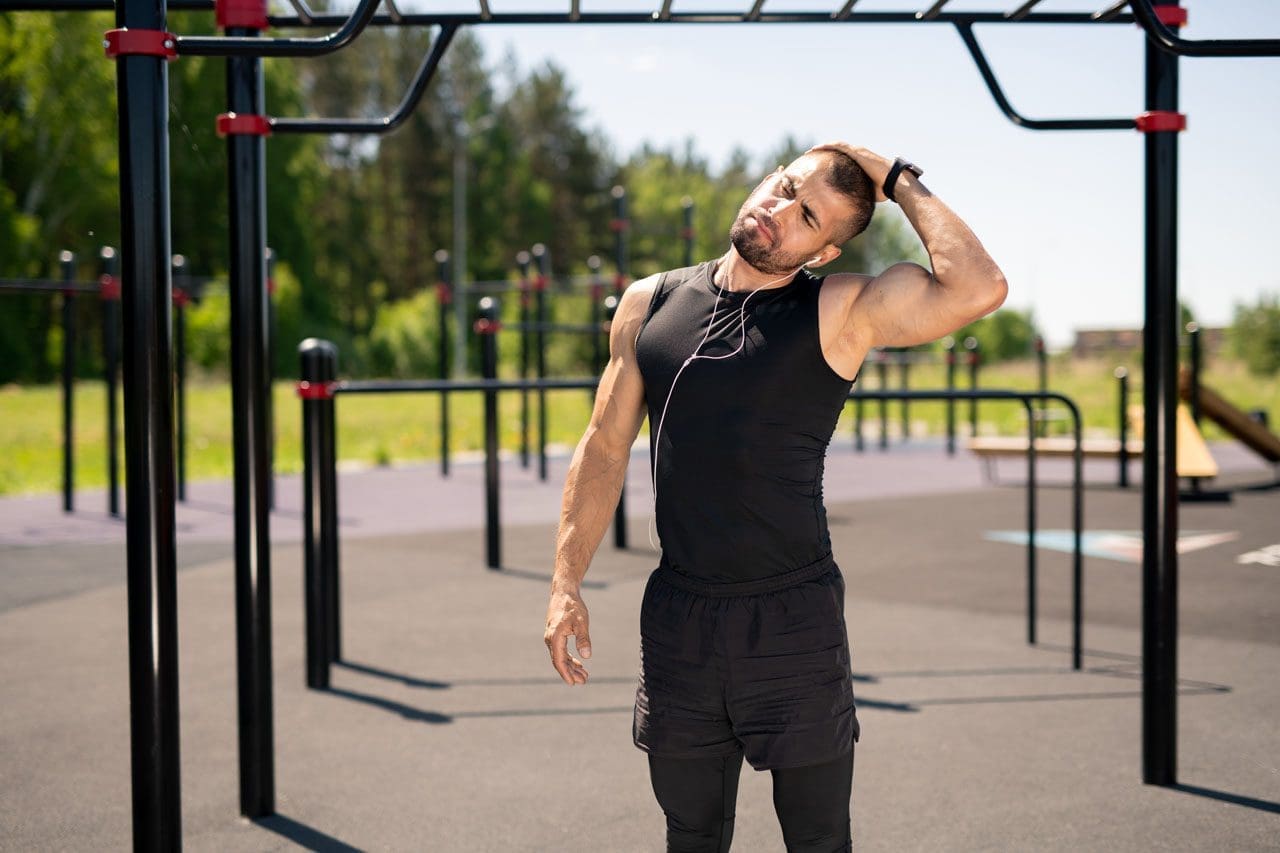Neck Bulging Disc/s Chiropractic Exercises and Stretches
- Chin Tucks
- Neck Extensions
- Isometric Holds
- Shoulder-Blade Squeezes
- Stability Ball Stretches

Bulging Disc In The Neck
When pressed out of its normal position the result can be the spine shifting to an awkward angle. This affects posture and can damage the surrounding nerves and joints. If left untreated, it could cause:- Dizziness
- Headaches
- Lack of flexibility
Avoid Exercises that are strenuous that involve excessive motions, like:
- Jumping
- Running
- Lifting weights
- As these can put a strain on the affected area and can make the pain worse increasing the risk of also tearing nearby discs.

Safe neck exercises and stretches
Chin Tucks
This stretch will move the upper vertebrae without causing further injury to the bulging disc. To do a chin tuck:- First, sit with proper posture.
- Gently tilt the head back toward the shoulders.
- There should be a feeling of the upper neck muscles slightly pulling together.
- Hold this position for a few seconds
- Slowly tilt the head down toward the chest.
- Carefully attempt to touch the chin to the upper chest.
- Hold for a few seconds.
- Repeat the process 10 times.

Stability Ball Stretches
Stability ball exercises and stretches are a great way to reduce a bulging disc. It allows for movement but prevents generating spinal pressure. One exercise requires carefully bouncing up and down. To do this:- Sit with correct posture in the center.
- Keeping the arms flat at the sides.
- Slowly move the body up and down.

Shoulder-Blade Squeezes
Shoulder-blade squeezes are great for releasing tension throughout the upper back. This calms the tight muscles that help heal a herniated or bulging disc faster. To perform:- Stand with proper posture.
- Make sure that the body is aligned but loose. If tension is present, it could make it harder to do the stretch.
- Slowly pull the shoulder blades so they meet.
- There should be a slight pull feeling.
- Hold the position for 10 seconds
- Bring the shoulders back to the original position.
- Repeat five times.

Bed Neck Extensions
This stretch works to extend the spine. It creates space between the vertebrae assisting by helping the bulging disc back to its proper position.- Lie on a bed horizontally, flat on your back.
- Line up the neck on the edge with the head slightly falling off.
- Tilt the head slowly toward the floor until the stretch is felt.
- Hold the position for about a minute.
- Lift the head back up.
- Continue the stretch a few more times.
- If there is any discomfort/pain/tingling sensation stop immediately.
Isometric Holds
Isometric exercises focus on a specific set of muscles. The isometric holds will help heal the neck muscles. This will help prevent them from pressing on the nerves and shifting the bulging disc further out of place and will relieve the pressure around the head and upper neck. It will stretch the neck muscles and increase blood flow.- Sit with proper posture.
- Place the palm on the top of the forehead.
- Firmly press the hand into the forehead.
- Try not to move the head.
- Keep pressing the palm into the forehead for 15 seconds
- Release.
- Repeat a few times.

Exercising and Stretching Tips
While these exercises and stretches are helpful and beneficial, keep in mind not to overdo them. If there is any pain when moving stop the exercise/stretch. Try to be as consistent with the exercises and stretches as possible. This will help the body heal properly and safely.Visit a Chiropractor
One of the best treatment options for anything spine-related is chiropractic. It works to heal the neck bulging disc and can help generate more flexibility throughout the body. The types of adjustments will depend on how severe the condition is. In most cases, the flexion-distraction technique is used. The chiropractor pushes their hands in specific areas massaging and manipulating the discs back into the proper position and form. This also reduces inflammation relieving the pain.Body Composition
Phase Angle Muscle Fat Analysis
Dialysis time can disrupt lifestyle habits that include:- Diet
- Exercise
- Leads to:
- Malnutrition
- Muscle loss
Disclaimer
The information herein is not intended to replace a one-on-one relationship with a qualified health care professional, licensed physician, and is not medical advice. We encourage you to make your own health care decisions based on your research and partnership with a qualified health care professional. Our information scope is limited to chiropractic, musculoskeletal, physical medicines, wellness, sensitive health issues, functional medicine articles, topics, and discussions. We provide and present clinical collaboration with specialists from a wide array of disciplines. Each specialist is governed by their professional scope of practice and their jurisdiction of licensure. We use functional health & wellness protocols to treat and support care for the musculoskeletal system’s injuries or disorders. Our videos, posts, topics, subjects, and insights cover clinical matters, issues, and topics that relate to and support, directly or indirectly, our clinical scope of practice.* Our office has made a reasonable attempt to provide supportive citations and has identified the relevant research study or studies supporting our posts. We provide copies of supporting research studies available to regulatory boards and the public upon request. We understand that we cover matters that require an additional explanation of how it may assist in a particular care plan or treatment protocol; therefore, to further discuss the subject matter above, please feel free to ask Dr. Alex Jimenez or contact us at 915-850-0900. Dr. Alex Jimenez DC, MSACP, CCST, IFMCP, CIFM, CTG* email: coach@elpasofunctionalmedicine.com phone: 915-850-0900 Licensed in Texas & New MexicoReferences
BMJ. 2017 Advances in the diagnosis and management of neck pain. Available at:Â pubmed.ncbi.nlm.nih.gov/28807894/ Mayo Clin Proc. 2015. Epidemiology, diagnosis, and treatment of neck pain. Available at:Â pubmed.ncbi.nlm.nih.gov/25659245/ Open Orthop J. 2016. A Qualitative Description of Chronic Neck Pain has Implications for Outcome Assessment and Classification. Available at:Â www.ncbi.nlm.nih.gov/pmc/articles/PMC5301418/Post Disclaimers
Professional Scope of Practice *
The information herein on "Neck Bulging Disc/s Chiropractic Exercises and Stretches" is not intended to replace a one-on-one relationship with a qualified health care professional or licensed physician and is not medical advice. We encourage you to make healthcare decisions based on your research and partnership with a qualified healthcare professional.
Blog Information & Scope Discussions
Our information scope is limited to Chiropractic, musculoskeletal, physical medicines, wellness, contributing etiological viscerosomatic disturbances within clinical presentations, associated somatovisceral reflex clinical dynamics, subluxation complexes, sensitive health issues, and/or functional medicine articles, topics, and discussions.
We provide and present clinical collaboration with specialists from various disciplines. Each specialist is governed by their professional scope of practice and their jurisdiction of licensure. We use functional health & wellness protocols to treat and support care for the injuries or disorders of the musculoskeletal system.
Our videos, posts, topics, subjects, and insights cover clinical matters, issues, and topics that relate to and directly or indirectly support our clinical scope of practice.*
Our office has reasonably attempted to provide supportive citations and has identified the relevant research study or studies supporting our posts. We provide copies of supporting research studies available to regulatory boards and the public upon request.
We understand that we cover matters that require an additional explanation of how it may assist in a particular care plan or treatment protocol; therefore, to further discuss the subject matter above, please feel free to ask Dr. Alex Jimenez, DC, or contact us at 915-850-0900.
We are here to help you and your family.
Blessings
Dr. Alex Jimenez DC, MSACP, RN*, CCST, IFMCP*, CIFM*, ATN*
email: coach@elpasofunctionalmedicine.com
Licensed as a Doctor of Chiropractic (DC) in Texas & New Mexico*
Texas DC License # TX5807, New Mexico DC License # NM-DC2182
Licensed as a Registered Nurse (RN*) in Florida
Florida License RN License # RN9617241 (Control No. 3558029)
Compact Status: Multi-State License: Authorized to Practice in 40 States*
Presently Matriculated: ICHS: MSN* FNP (Family Nurse Practitioner Program)
Dr. Alex Jimenez DC, MSACP, RN* CIFM*, IFMCP*, ATN*, CCST
My Digital Business Card






 Again, I Welcome You.
Again, I Welcome You.
Comments are closed.